Refraction of light rays
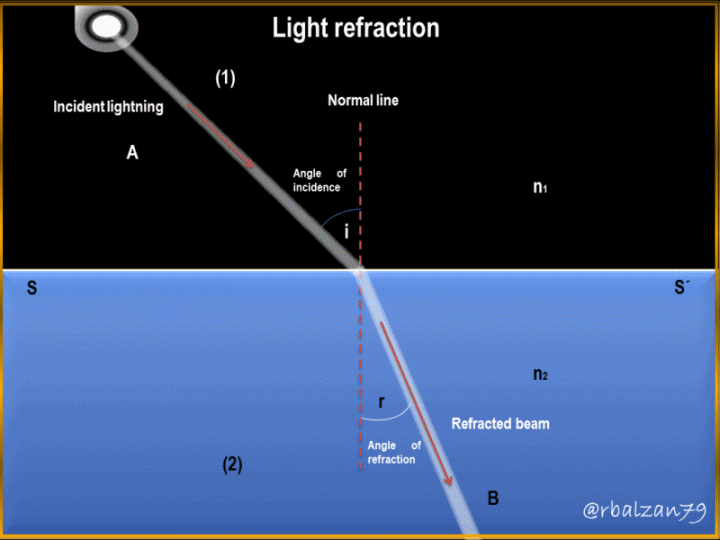
Introduction
In this article we will continue to expand the knowledge related to the essential phenomenon of light, in the previous delivery we were able to observe and verify through some practical everyday experiences how this phenomenon spreads, and it does so by following the geometric location of a straight line, and thus we begin the extraordinary journey of understanding our spectrum of white or visible light, helped of course by geometry and optics, ie geometric optics.
In accordance with the above, it is important to bear in mind that geometrical optics is based on elementary principles such as the propagation of light in a straight line.
Complementing the foundation of geometric optics we find the phenomena of reflection and refraction of light, we could witness in the previous article a form of reflection of light rays emitted by a flashlight when hitting a flat surface, in this case a mirror, we note that the light beam changed direction but not the initial means of propagation so we say that the light beam was reflected.
In this opportunity we will begin to know the phenomenon of the refraction of the luminous rays, and the same one indicates us that a certain beam of light will transit from a physical means to another one, this way is originated mainly the change of the speed of the light and with it its orientation, we will carry out a series of practical experiences with the purpose of being able to observe the due behavior of the light when it is refracted.
In many occasions we are in presence of this type of phenomenon of the refraction of the light rays but we do not realize it, the intention of this article is to be able to show some daily examples related to the important phenomenon of the refraction of our essential light, and this way to continue strengthening our knowledge as for the comprehension of the above mentioned luminous phenomenon.
Light refraction
This fabulous phenomenon occurs when a beam of light crosses a certain limit surface or border between two material means or of different propagation, when this happens we will observe a deviation of this beam of light due to the change of the speed experienced by the light when passing from one means to another, that is to say, by different means, and whose refraction index will clearly be different since it will depend on the type of means that will be crossed, as we can observe in the following figure 1.
Figure 1. Light refraction

In figure 1, we observe how light travels through two different mediums one of which we can call (1) and with refractive index n1, and this light when it reaches the separation surface (which we can denote with SS') between the mediums 1 and 2 and whose refractive index of the second medium is n2, when the light crosses the surface SS' it will begin to transit through the second medium (2) but with a certain deviation, for this phenomenon we find some laws that govern it which are:
All the elements related to the path of refraction of the light such as; incident ray, refracted ray and the normal one to that surface of separation in the respective point of incidence we will find them involved in a same plane.
In the refraction of light, the sinuses representing both the angle of incidence (i) and the angle of refraction (r) have the following relationship or formulation:

In equation 1, n represents the index of refraction corresponding to the second medium in relation to the first one, therefore:

In this way we can start practical experiences aimed at understanding the phenomenon of light refraction, therefore we have the following:
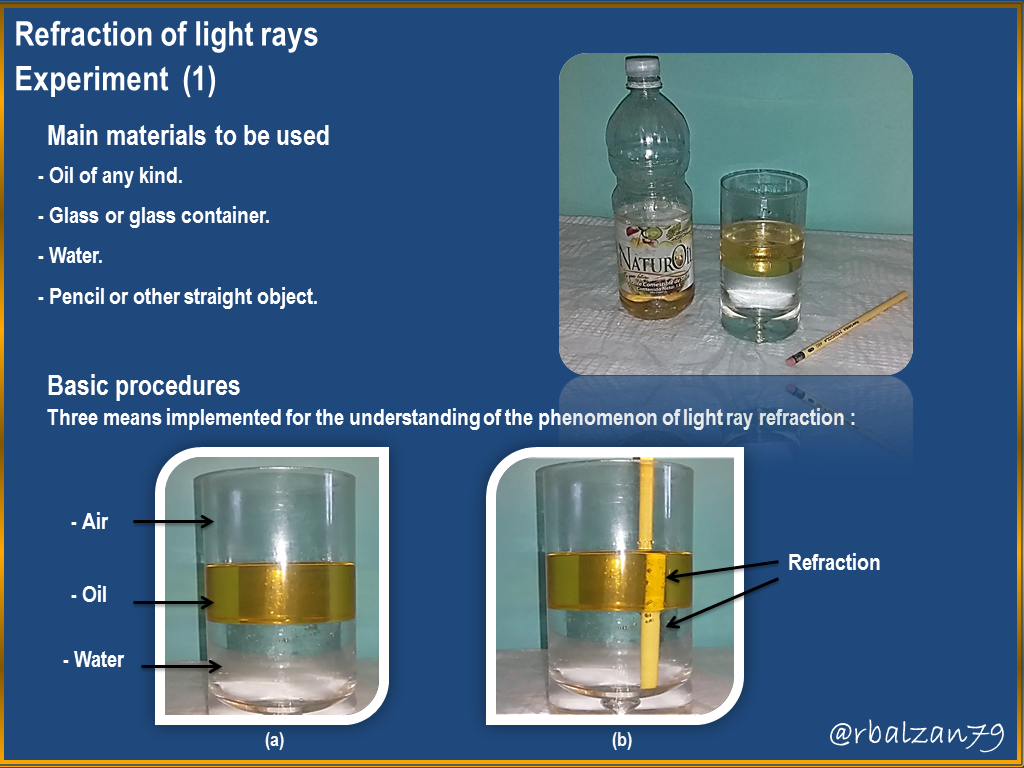
In the previous figure or image we can notice a small sample of the refraction of the luminous rays of certain beams of light, we noticed the presence of three (3) different means such as; air (upper part), oil (intermediate part) and water (lower part), these three means have different refraction indexes what allows to be able to observe the double of the luminous rays when passing by these different material means, but my friends to be able to enjoy in a better way this experiment I invite you to visualize the following video.
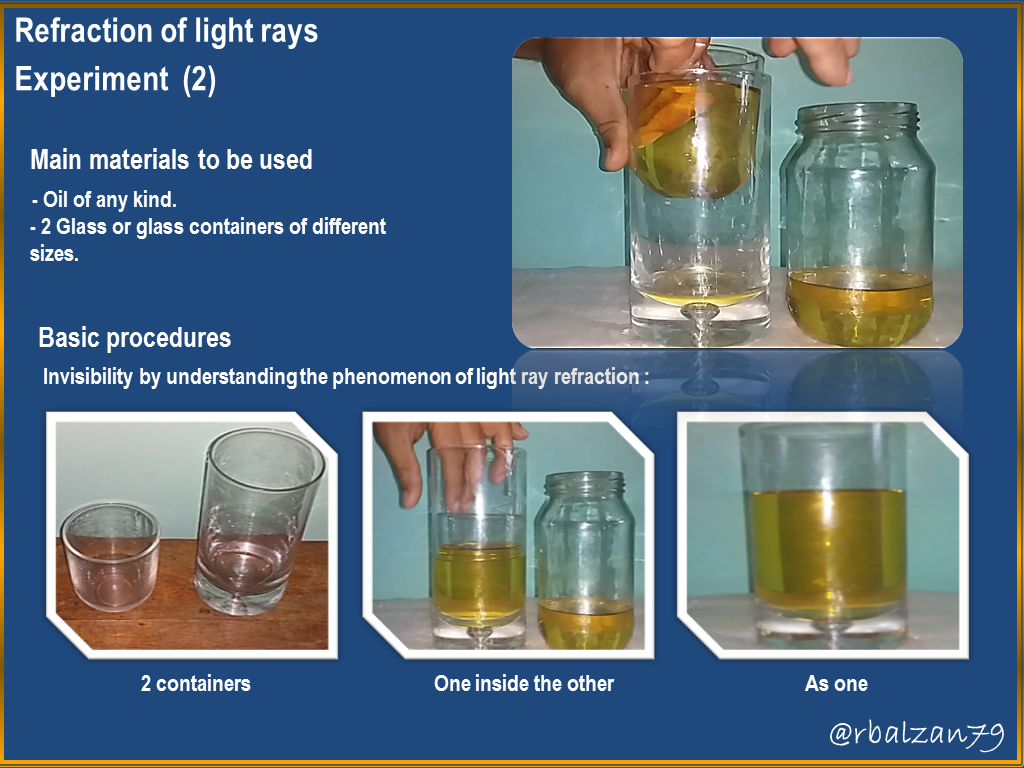
In the previous figure we can visualize the materials implemented in our experiment 2, where, when introducing a container inside the other and filling with oil the container of greater volume until covering the smaller one, this last one we cannot distinguish it as if the internal transparent container disappeared, therefore, we can express that the index of refraction of both the liquid used (in this case oil) and the glass are equal, and in this way they manage to divert or bend the luminous rays in a similar way, then, when passing in a straight way and not deviating (between the oil and the glass) we observe only the oil inside the container of greater volume, but we better observe this experiment in the following video:
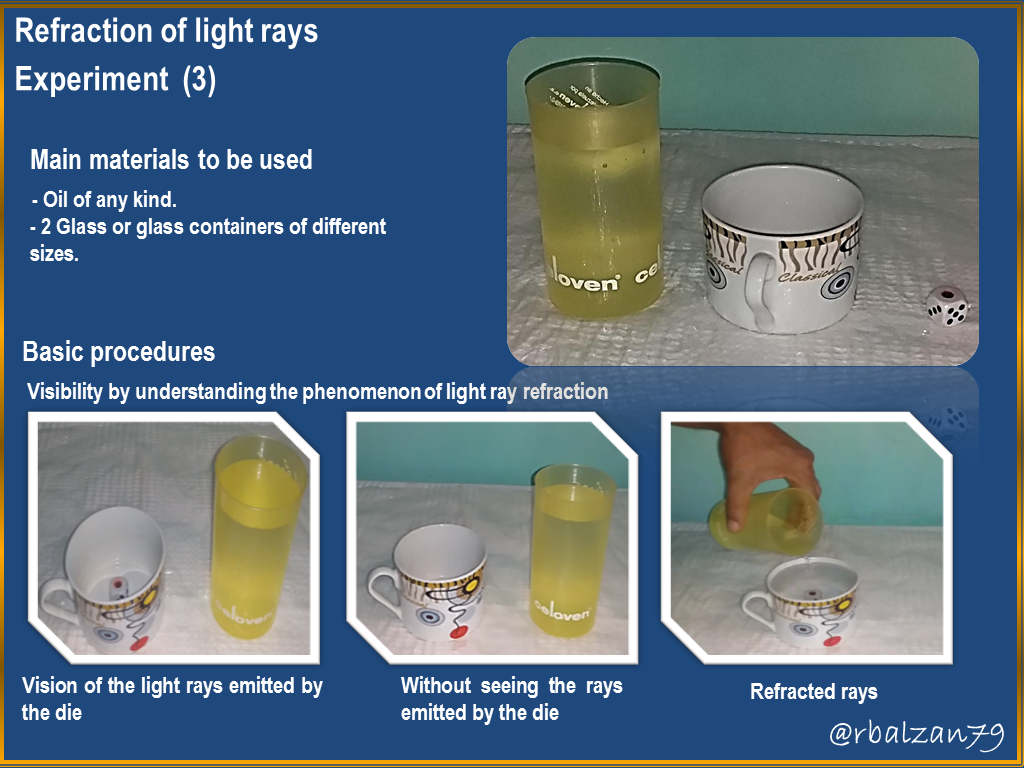
This experiment consists in making visible an object that initially we cannot visualize or its luminous rays do not reach our natural optical systems (eyes), and thanks to the refractive index of water it makes those luminous rays reach our eyes, as if the object (in this given case) rose before our eyes, and the reality what happens is that the rays emitted by that die are refracted until they reach our eyes when we add the water, but I invite you to watch the following video so you can enjoy this experience.
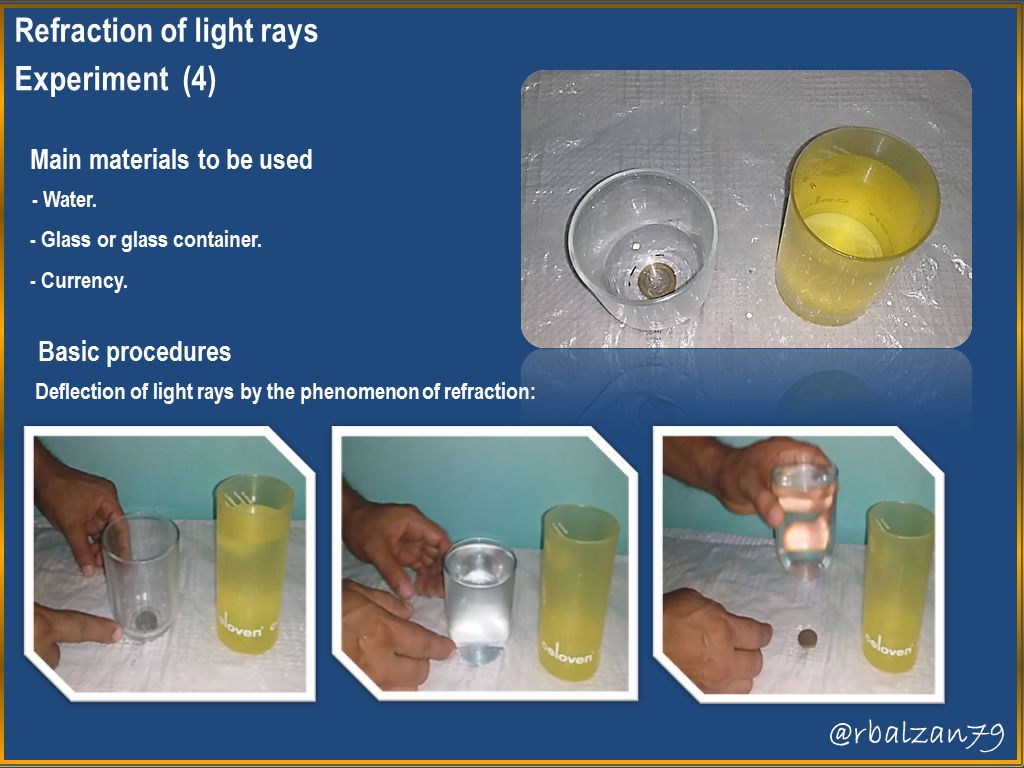
Contrary to the previous experience, in this opportunity we can initially visualize a coin as if it were inside a transparent container and after placing water in that container we notice that it disappears, but, in one of our images we notice that the coin is not inside the container but underneath, this makes the rays emitted by the coin go initially from the air to the glass, then to the water, from the water to the glass and finally from the glass to the air again, because of all these changes of material means, these luminous rays are diverted and do not manage to point towards our eyes, and therefore, to our sight the moderation disappears, but let's enjoy the following video referring to the above mentioned.
Conclusion
Geometrical optics and its essential interpretations related to the behaviour of light provide us with any kind of knowledge about this essential phenomenon for mankind. We observe the phenomenon of refraction every day and everywhere we are, since our environment is full of light-refracting figures.
Our natural environment is composed of various material or physical means which have a certain behavior when a beam of light passes through them, mainly affecting the speed of propagation of this phenomenon, this is the essential or fundamental reason for the phenomenon of refraction.
During the development of this article we could enjoy four (4) small but significant experiments related to the important phenomenon of the refraction of the luminous rays emitted by any object that is to our environment, and this way we can observe different behaviors according to the characteristics or means to use, as we could verify in each one of the previous experiences.
Until another delivery my appreciated readers of Hive.blog, especially to the members of the community of #stemsocial, for which I recommend widely to be part of this wonderful project, since it allows us to value the great task of the academy and the great effort of the scientific field.
Note: All the images are of my authorship and were elaborated using Power Point and the animated gif was elaborated with the application of PhotoScape, the audio-visual material was made using the optical instrument (video camera) of the cellular phone ZTE BLU Life Play 2, in addition the same one was edited implementing the application of Wondershare Filmora (Build 7.8.9).
@tipu curate
Upvoted 👌 (Mana: 0/5)
Thanks for the support @byercatire with tipu. Greetings
Excelente trabajo
Gracias amigo @amart29 por comentar. Saludos.